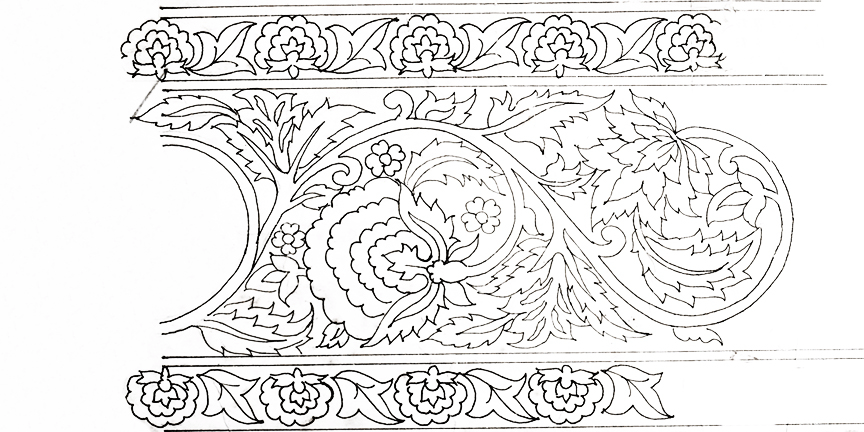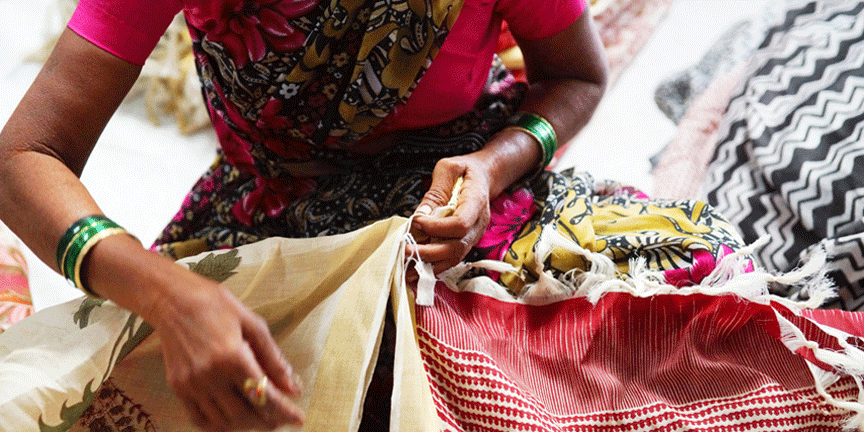Process
Here at Parekh Bugbee all of our textiles are made by hand from start to finish using all natural dyes and fabrics – pure silk, pure wool and organic cotton.
There are many intricate steps, and many hands, involved in the making of our wearable art.

The Parekh Bugbee family factory in Mumbai, India built in 1968 largely from recycled materials.
The silkscreen printing process is a print-making technique in which a mesh cloth is stretched over a heavy metal frame. The design is exposed on the screen by passing it through laser in a screen-making machine or affixed by stencil.
Once all of the screens for a specific design are ready (one screen per color) the fabric is then printed on by applying even and direct pressure using a squeegee to force color dye through the minute pores of the screen material onto the fabric.
It can days or sometimes weeks to perfect textiles into exquisite scarves and shawls. Our own team of artisans follow these steps to bring the prints and designs to life.
- Step #1 Drawing of the designs:

The first step in the print design process starts in our studio where our artist starts with a paper drawing of the design.

After the design is complete, the artist colors the design to determine the combinations needed for the particular print.
- Step #2 Making of the silkscreens:
The next step involves making the necessary silkscreens of the design. Each color necessitates its own screen.
 Our artisan taking the stretched and ready screens onto the factory printing floor.
Our artisan taking the stretched and ready screens onto the factory printing floor.
- Step #3 Preparing the fabric for printing:

Our team then prepares the fabric for printing:
After we receive the natural plain fabrics from the weaving mills, we prepare the fabric by washing it 2 or 3 times by hand in warm water to “degum” the material. Degumming literally means the removal of gum from a fabric – especially the removal of sericin, a protein created by the silkworm. This step essentially cleanses the natural silks, wools and cotton fabrics.
In order to give the fabric its natural shine, we then dry the fabric under direct sunlight for 3-4 hours to make sure it dries completely.
- Step #4 Preparing the hot wax tables:


The workers then prepare the hot wax tables by washing them for the just prior to laying out the fabric (115 to 122 degrees Fahrenheit).
Once the tables reach the optimum temperature level, the fabric is then stretched carefully by two sets of hand people directly on the hot wax tables.
- Step #5 Making of the colors:



The color master then checks the colors and individually numbers and arranges each color for the silkscreens.
- Step #6 Silkscreen printing on the fabric:



Our expert print artisans then lay the first color on the fabric by passing a squeegee back and forth between them to make the print impression evenly on the fabric. This process is repeated several times until all the colors are printed onto the fabric.
- Step #7 Drying and color fastening of the prints:

When all the colors are dry after printing, the fabric is then collected and taken for steam processing to fasten the colors onto the fabric.
- Step #8 Color fastening through water steam machine:


The printed fabric is then passed through a hot steam-rolling machine heated to 250 degrees Fahrenheit to insure the color sets onto the fabric and the natural acetic dyes permanently fix to the natural fibers of the fabric.
- Step #9 Final washing:

After the steam processing, we then repeat a washing of the printed fabrics hand in cold water up to 3 or 4 times in order to clear all excess color from the fabric.
We recycle all of the water used in our printing process by our own underground filtration process where the natural dyes are separated and neutralized through its filter. Reclaimed clean water is then recycled back into the factory unit for continued washing or is redirected to our adjacent farm for irrigation of organic fruits and vegetables.
- Step #10 Final drying under natural sunlight:

The printed fabric is then laid out again in the sun for almost a full day. Natural sunlight brings out the shine in the fabric and fastens the color as a final step.
- Step #11 Finishing and Inspection:


As a step in final finishing, the shawl, scarf or stole is then inspected carefully for any flaws or leftover residual wax from the hot wax tables.
- Step #12 Ironing and shipping:

 It is then manually ironed, carefully folded and ready to be shipped to our studio here in the USA.
It is then manually ironed, carefully folded and ready to be shipped to our studio here in the USA.




